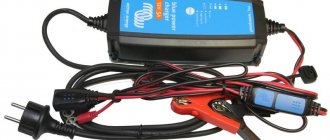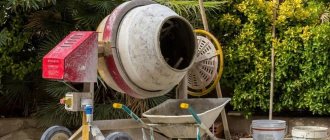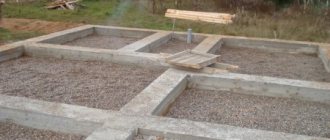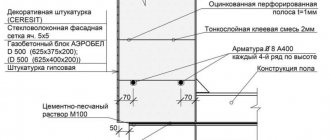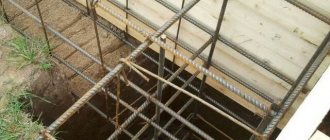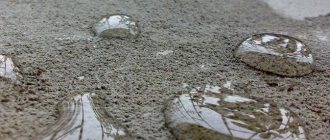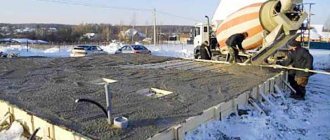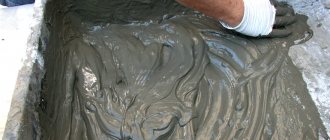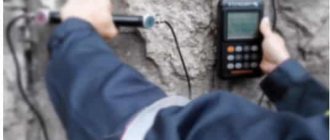Technical aspects of the problem of reinforcement corrosion
In production practice, situations are almost impossible when reinforcing bar blanks would not be covered with rust already in the factory. Huge deposits of reinforcement laid at shipping sites in the open air are clear confirmation of this. Such an attitude towards storing metal products would not surprise anyone today. The most important factor taken into account when assessing the danger of rust on reinforcement blanks is the degree of damage to the steel structure.
A light coating of rust, which does not in any way affect the strength characteristics of the reinforcement.
On average, in the first year, steel is covered with a layer of rust 0.2-0.3 mm thick, then the rate of its spread slows down, and it will take about 10 years to reach a depth of 1 mm. The thicker the rust layer becomes, the slower the corrosion rate, as it prevents oxygen and moisture from reaching the metal surface.
The rate of rust spread may be lower for low-alloy steel stored in a dry climate and protected from precipitation. Corrosion of reinforcement of high grades occurs faster, with thermal or mechanical treatment, in a humid and salt-containing environment.
Corrosion of reinforcement in concrete
If the structures use iron reinforcement poured with concrete, i.e. reinforced concrete, another type of destruction is possible - corrosion of reinforcement in concrete. Under the influence of environmental waters or the presence of hydrogen sulfide, chlorine, or sulfur dioxide gases in the air, the reinforcement in the middle of the concrete rusts and iron corrosion products are formed. In volume they exceed the initial volume of the reinforcement, which leads to the emergence and growth of internal stresses, and subsequently to cracking of concrete.
Air and moisture penetrate through the pores in the cement stone to the reinforcement. They are not supplied evenly to the metal surface, which is why different potentials are observed in different parts of the surface - electrochemical corrosion occurs. The rate of electrochemical corrosion of reinforcement depends on the moisture permeability, porosity of the concrete stone and the presence of cracks in it.
The presence of dissolved substances in water increases corrosion of fittings with increasing electrolyte concentration.
When concrete is exposed to air for a long time, a very thin (5 - 10 microns) protective film is formed on the surface, which does not dissolve in water and does not interact with sulfates. The process of formation of a protective film under the influence of carbon dioxide in the air is called carbonization. Carbonation protects concrete from corrosion, but promotes corrosion of reinforcement in concrete.
You cannot reinforce concrete that contains calcium chloride (more than 2% of the weight of cement). Calcium chloride accelerates the corrosion of reinforcement both in air and in water.
Protection of concrete reinforcement from corrosion
There are several ways to protect steel reinforcement in concrete from corrosion: improve the environment surrounding the metal (i.e., use high-quality concrete of a special composition, introduce inhibitors); additional protection of concrete reinforcement from corrosion (film, etc.); improve the characteristics of the metal itself.
Around the reinforcement there is concrete itself, so concrete is the medium surrounding the metal. To extend the service life of reinforcement, it is necessary to improve the effect of concrete stone on steel. First of all, it is necessary to exclude or, if this is not possible, to minimize the substances included in the composition of concrete, which contribute to the intensification of the process of corrosion of reinforcement in concrete. These substances include thiocyanates and chlorides.
If a reinforced concrete product is operated under conditions of periodic wetting, it is necessary to impregnate the concrete with special impregnations (bitumen, petrolatum, etc.). This will significantly reduce the permeability of concrete. With constant saturation of the concrete stone, corrosion of reinforcement in concrete is practically reduced to a minimum. This is explained by the fact that the penetration of oxygen to the metal surface is very difficult, and the cathodic process is significantly inhibited.
To extend the service life of the metal base of reinforced concrete, the concrete is refined. During the formation of the concrete mixture, corrosion inhibitors are introduced into the composition.
To protect reinforcement from corrosion in structural thermal insulating concrete, the ohmic limitation method is widely used. The bottom line is that the moisture content of the concrete itself should not exceed the equilibrium value at a relative air humidity of 60%. Then the corrosion processes of the reinforcement almost stop, because A high ohmic resistance of moisture films occurs at the surface of the reinforcement. This method is not so simple and is not effective in areas with high humidity and frequent precipitation.
Good concrete must have an initial passivating effect on the reinforcement. Concrete products dry completely in about 2-3 years. If the climate is dry, then a little faster. It is at this time that the most severe corrosion damage to the reinforcement occurs, because it is in a damp concrete environment.
A good way to protect concrete reinforcement from corrosion is considered to be preliminary passivation of the surface of the reinforcement, as well as the formation of oxide protective films under the influence of the aqueous alkaline environment of the concrete stone. The protective properties of the film are enhanced by introducing passivators into the concrete mixture. Sodium nitrite is often used in an amount of 2 - 3% of the original weight of cement.
How rust interacts with cement
Under certain conditions, the artificial combination of rust with cement leads to the so-called “adhesive effect,” that is, a light coating of rust improves the adhesion of the reinforcement to concrete, this is explained as follows.
High-quality Portland cement, according to technical indicators, contains from 2 to 4 percent of iron oxides, and high-quality compositions made on the basis of slag components contain up to 10 percent of the same oxides. As a result, when the cement hardens, rust reacts with oxides, causing the effect of “sticking” the concrete to the surface of the reinforcing bars and blocking the oxidation process.
In addition, the presence of rust indicates the absence of technological lubricant on the metal, which prevents good adhesion of the surface of the rod to the concrete. Therefore, you should not worry about a slight red coating on steel bars and try to clean it off by any means.
What leads to rusting of the reinforcement cage
There are several reasons for rust to appear on the metal inside the concrete mass. And these are not always external influences.
- Internal corrosion can be caused by the presence of a large number of aggressive components in the water used to mix the concrete mixture. In addition, to create reinforced concrete, you cannot use a composition containing more than 2% (by weight of cement) calcium chloride. Since this element significantly accelerates the corrosion of reinforcement in concrete when used in any environment.
- The density of laying the concrete mixture is of no small importance. The fact is that the presence of a large number of pores, voids, cavities allows moisture and air to penetrate inside the product, to the reinforcement frame. As a result, different electrical potentials arise in different parts of the metal circuit, which leads to electrochemical corrosion.
- The concept of physical corrosion is associated with the destruction of concrete as a result of its alternate freezing and thawing. This trouble can be avoided by creating favorable conditions while the concrete gains strength to a given value.
In order to correctly assess the situation and take measures to correct it, it is necessary to understand the level of the threat. To determine the degree of corrosion of reinforcement and concrete, physical and chemical methods are used:
- Study of the composition of components newly formed in the concrete mass under the influence of aggressive substances. Research is carried out in the laboratory using differential thermal and x-ray structural diagnostics on specially selected samples.
- Conducting a visual inspection of the altered structure of concrete in a structure using a magnifying glass. This method allows you to identify many surface defects.
- Powerful microscopes help to detect the nature of the arrangement and connection of cement stone elements with aggregate grains. As well as the state of contact of concrete with reinforcement, dimensions and direction of propagation of cracks.
To determine the strength characteristics of operating concrete and reinforced concrete structures, non-destructive testing methods are used in accordance with the recommendations and requirements of GOST 18105-86.
How to choose reinforcement taking into account the degree of its corrosion
Any professional builder should be able to assess the condition of the reinforcement used for laying. When conducting an expert assessment, he will have to refer to the official document “Recommendations for the use of reinforcement with traces of rust” dated 2004.
Degrees of corrosion of reinforcing bars
According to the recommendations of the document on the use of reinforcement with traces of rust for reinforcing reinforced concrete structures, there are 4 degrees or categories of corrosion of steel rods.
- A light and barely noticeable coating of rust, the presence of which does not affect the color of the steel, properties and technical characteristics (strength and total weight, in particular).
- The presence of clearly visible dense rust on the surface, which can be almost completely removed with a metal brush or rag.
- The third category is local surface corrosion. It is characterized by a light layer of rust, which was formed as a result of moisture, it can be easily removed with a rag or brush.
- The fourth degree is the presence of a voluminous corrosion coating formed during prolonged oxidation in the open air or in conditions of high humidity. After cleaning such rust, traces of pitting corrosion remain on the reinforcement, and the cross-section of the rods is reduced.
Steel reinforcement bars with varying degrees of corrosion.
At the initial stage of corrosion (first degree), there is no reason to worry, since a light coating will disappear even when pouring the concrete mixture. Moreover, this will not affect the cross-section of the rod in any way.
For reinforcing strip foundations, slab foundations, grillages, and other concrete structures, it is allowed to use reinforcing steel of the first 3 categories that has not been cleaned of rust. In a situation where circumstances force you to purchase cheap fittings with traces of severe rust, it is not recommended to use it without preliminary cleaning and inspection by specialists.
Principles of protection
Thus, concrete in this zone is protected by two methods at once: internal structural changes in the characteristics of concrete and external treatment. Only a combination of these methods can save the foundation from destruction.
In specialized construction stores you can always buy organic and mineral additives that increase the strength and durability of concrete before exposure to aggressive environments.
It is recommended to carry out secondary treatment with expensive hydrophobic compounds, as well as polymer liquid mixtures. The main purpose of such protection is to fill the air formations and pores of concrete with compounds that are resistant to external aggressive environments.
Kawabanga! Difference between concrete and cement mortar
Also, in the process of applying the compositions, a durable protective film is formed on the concrete surface itself. The coating is used at the stage of laying the foundation or during its repair.
GOST recommendations on rust
In the 6th paragraph “Acceptance”, in the general technical conditions of GOST 10922-2012 “Reinforcing and embedded products, their welded, knitted and mechanical connections for reinforced concrete structures”, it is written:
- the use of steel rods with a thin coating of rust is not a reason for rejecting the reinforcing structure. Such plaque completely disappears during the concreting process, as a result of exposure to the alkali contained in the concrete mixture.
- If a layer of rust gets dirty and peels off, it must be cleaned from the surface of the reinforcement before concreting, using a metal brush and a rag, or even rinsed with a strong stream of water and blown with compressed air.
Types of concrete corrosion
Precipitation containing acids and even air near many industrial enterprises (gas corrosion) can have a harmful, destructive effect on concrete. As well as water from rivers, seas, soil, drainage systems and wastewater. When the structure is made of reinforced concrete, then to the external factors there is also added the danger of corrosion processes in the reinforcement.
Depending on the nature of the impurities contained in the external environment, corrosion of concrete and reinforced concrete is divided into three types:
- 1 type of corrosion – decomposition of cement stone as a result of leaching of calcium hydroxide. This element may be present in the concrete mixture from the moment it is formed, or may be formed during exposure of the finished structure to water containing harmful impurities. Ca(OH)2 is the component that dissolves most easily and is most quickly washed out of the concrete body, thereby destroying it.
- Type 2 – implies the disintegration of cement stone from interaction with acids. This type is called chemical corrosion. In this case, easily soluble lime products are washed out in the structure, or the opposite process occurs. Under the influence of aggressive waters, sediments that do not have astringent properties are formed in the concrete body. As a result, the product loses strength and turns into a weak, loose mass. This category can include alkali corrosion, which is caused by an excess of antifreeze additives during the formation of a concrete mixture.
- Type 3 corrosion is a process in which, under the influence of acid, a calcium compound is formed that is insoluble in water. CaCO2 or CaSO4 gradually fills the free pores in the concrete mass, increasing its volume, which ultimately leads to the destruction of the structure. Of all the types of category 3, sulfate corrosion is the most common in practice.
It is clear that such a division is conditional, since it is not always possible to determine with great accuracy what exactly influenced the corrosion of a particular structure.
Corrosion processes usually occur under the influence of a combination of various factors, and several categories of destruction can occur simultaneously.
Among other things, the absence or presence of corrosion of reinforcement in reinforced concrete has a significant impact on the integrity of the structure.
How to properly store fittings?
In order to protect the fittings from corrosion, they must be stored in dry, closed and well-ventilated areas where air humidity does not exceed 70%. If stored outdoors, it is necessary to completely eliminate the possibility of exposure to moisture; for this purpose, a canopy should be built.
An example of outdoor storage of fittings that are planned to be used in the near future.
When storing reinforcement outdoors, you should check the condition of the steel rods once a month, if necessary, clean them so that grade 4 rust does not form on it.
It should be noted that classes of fittings of newer brands stored outdoors, such as A400S and A500S, in contrast to grade A3 (steel 35GS, 25G2S), are more susceptible to corrosion and rust faster. But the loss of strength for both in the first year of storage is the same, at the level of 1-3%, this is much less than the permissible deviations for building structures and reinforced concrete products.
Follow the storage rules and recommendations for using rusty reinforcement for concrete reinforcement to avoid unpleasant consequences in the form of cracks and peeling. After all, the quality of the entire reinforced concrete structure depends on the quality of the steel rods used.

